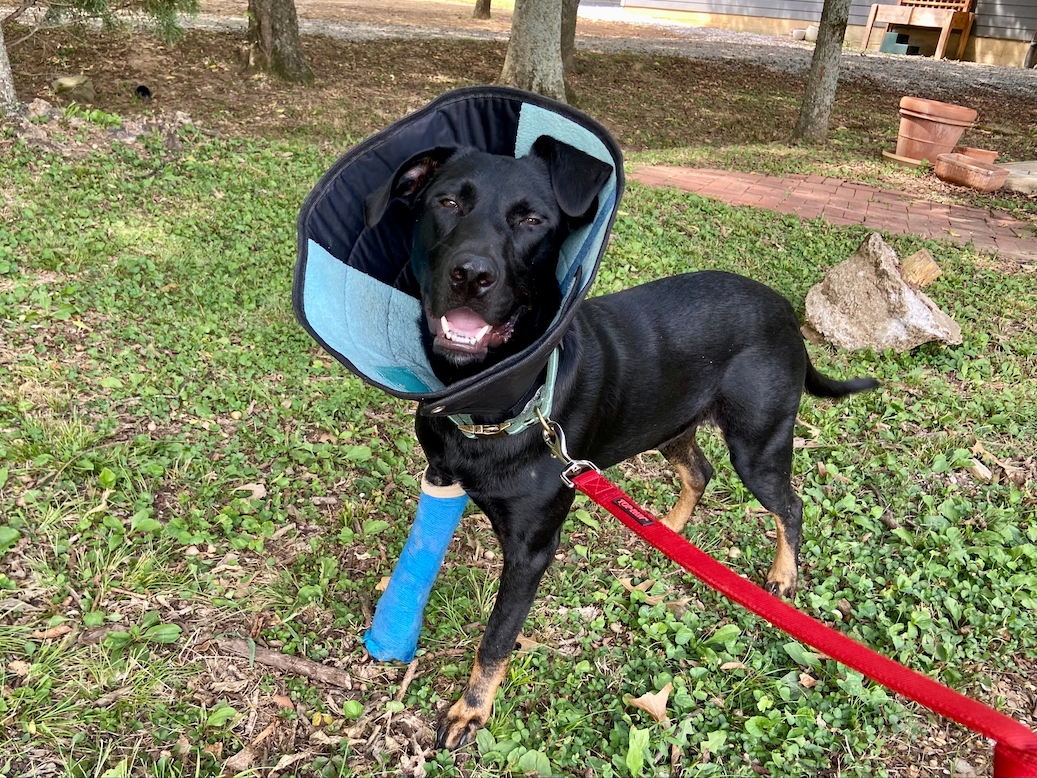

You notice your dog limping, isn’t eating, or overall isn’t really acting like themselves. It’s time to bring them to the vet to zero-in on what’s going on—beyond the naked eye.
After conducting a physical exam and asking you some questions, your vet may recommend diagnostic tests, including x-rays.
X-rays (also called radiographs) are a very valuable tool that can help your vet pinpoint exactly what’s wrong with your dog so you can make an appropriate treatment plan. But, like many veterinary procedures, x-rays can get expensive.
Let’s take a look at average costs, as well as how your pet health insurance can help take the bite out of some of those x-ray bills.
- X-rays are commonly used to help vets see foreign objects in a dogs stomach, broken bones, or bladder stones, as well as diagnosing orthopedic issues and illnesses like periodontal disease and cancer.
- Basic diagnostic x-rays usually cost between $75–$250, but can cost as much as $400 depending on the location of the injury/illness.
- A base Lemonade pet insurance policy can help cover the costs of your dog’s x-rays for eligible accidents and illnesses.
Average cost of a dog x-ray
Basic diagnostic x-rays cost an average of $75–$250, while more complex x-rays can cost $400 or more. Keep in mind there are other factors that might affect the cost of your pup’s x-ray procedure.
What else can affect the cost of a dog x-ray?
Sedation
If your dog is anxious or in pain and needs to be sedated for the x-ray procedure, you’ll need account for the cost of sedation. Sedative dosage depends on the weight and size of your dog; sedation will cost more for large dogs, and less for small dogs.
The vet practice and location
X-rays tend to cost less at smaller veterinary clinics, while larger practices often have higher rates. X-rays at emergency animal hospitals often cost more, too.
Your geographical location can influence costs. If you live in an area with a higher average cost of living, you will probably also pay more for x-rays (and other veterinary medicine services) than you would pay in an area with a lower cost of living.
Location of the injury or illness
Expenses can also vary depending on the type of x-ray your dog needs. If the underlying issue is difficult to find or see clearly (for instance, if it’s located in the joints and ligaments), and your vet has to take many films, the costs can increase.
If you’re worried about the cost of your dog’s x-rays, it’s best to have a conversation with your vet before the procedure. Your vet will be able to give you an estimate, and you can ask them to check in with you to approve additional x-rays if the costs end up being higher than anticipated.
Will pet insurance cover my dog’s x-ray?
In many cases, yes!
A base policy with Lemonade Pet helps cover the costs of diagnostics, procedures, and medication related to unexpected and eligible accidents and illnesses. So, for example, pet insurance would help cover the costs of an x-ray (and any necessary sedation) if your dog swallowed something they weren’t supposed to, broke a bone, or came down with a new orthopedic illness.
Plus, if you opt for dental coverage, we’d also help cover the costs of eligible dental x-rays in the event your dog develops periodontal disease or requires a tooth extraction.
Wondering if pet insurance is worth it? Check out how much pet parents of dogs have saved on vet bills by signing their fur baby up for pet insurance.
That said, pet insurance would probably not help cover the costs of your dog’s x-rays if it is related to a pre-existing condition, or if your plan’s relevant waiting periods weren’t up yet.
When do dogs require x-rays?
X-ray images are very helpful diagnostic tools, and they’re used in many different situations, such as:
- Viewing foreign objects in your dog’s stomach or intestines to identify the cause of an obstruction or blockage
- Evaluating changes to major organs like the heart, lungs, liver, or spleen
- Identifying and evaluating broken bones, fractures, or bone deformations
- Viewing bladder stones
- Diagnosing hip dysplasia, elbow dysplasia, and other orthopedic issues
- Evaluating dogs who have sustained major trauma (like having been hit by a car)
- Identifying signs of cancer
- Confirming the number of puppies a pregnant dog is going to have
- Diagnosing dental issues, including periodontal disease
- Evaluating hip and joint health to get a dog certified for breeding
Vets often use x-rays to diagnose health problems, and they may use them to monitor your dog’s progress as they heal from a fracture or other problem. X-rays are fast and painless, and since they provide instant results, they’re helpful for many different situations, especially in emergencies.
In some cases, there may be other types of diagnostic testing that a vet might use in addition to or even instead of x-rays. If you’re unsure of whether your dog really needs x-rays, don’t hesitate to discuss your questions with your vet.

What will and won’t show up on an x-ray?
X-rays use electromagnetic waves to create pictures of your dog’s organs, muscles, blood vessels, and bones. But x-rays don’t reveal everything, and they aren’t right for every scenario.
An x-ray doesn’t display every material well, including some plastics and even tumors, which can blend in with the appearance of other tissue on the film. X-rays also don’t provide very clear images of certain parts of the body—including your dog’s brain, inner heart, lungs, bladder, or some abdominal organs.
Depending on your dog’s situation, and what your vet believes might be wrong, your vet might perform an ultrasound, MRI, or CT scan instead. Ultrasounds use sound waves and create live images of your dog’s soft tissue. They can be used to confirm pregnancies and are also used to diagnose issues like the presence of fluid in a dog’s chest.
Magnetic resonance imaging (MRIs) and CT scans provide high-definition scans that are ideal for identifying small issues that a traditional x-ray could miss.
Will radiation affect my pup?
X-rays use electromagnetic radiation to create an image of your dog’s body. That radiation can be harmful if your dog is repeatedly and extensively exposed.
Don’t worry, though. When x-rays are taken, your dog receives very minimal exposure to radiation, and dogs can have many x-rays taken during their lives without experiencing any related health issues.
Your vet will further minimize the radiation your dog is exposed to by covering your pup’s body with protective shields, similar to the protective vests that you often see radiation technicians wear. By leaving just the area that needs to be x-rayed exposed, your furry friend will receive very little exposure to radiation.
Before we go…
Budgeting for vet bills is just part of prioritizing your dog’s health, so they can live the best life possible.
If your dog needs x-rays, those vet bills can get pretty expensive pretty quickly. Investing in pet health insurance for your dog can help you to be prepared if the unexpected ever happens.
Knowing that you’ll be able to have x-rays done without worrying about the costs can be very reassuring, and it can help your vet to quickly diagnose and treat your best friend, and so you can focus on your dog’s care, not your wallet.
A few quick words, because we <3 our lawyers: This post is general in nature, and any statement in it doesn’t alter the terms, conditions, exclusions, or limitations of policies issued by Lemonade, which differ according to your state of residence. You’re encouraged to discuss your specific circumstances with your own professional advisors. The purpose of this post is merely to provide you with info and insights you can use to make such discussions more productive! Naturally, all comments by, or references to, third parties represent their own views, and Lemonade assumes no responsibility for them. Coverage and discounts may not be available in all states.




